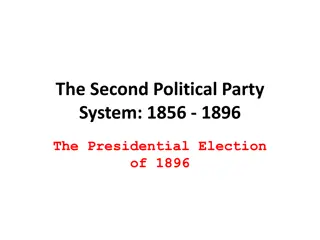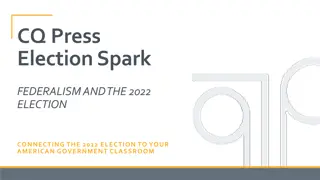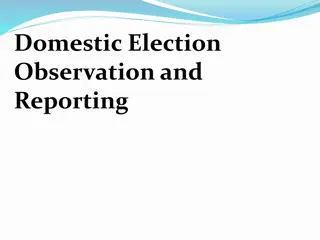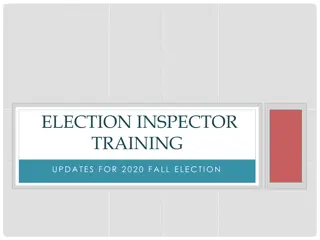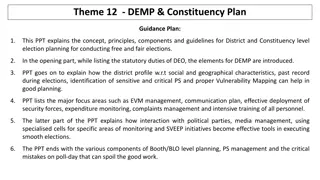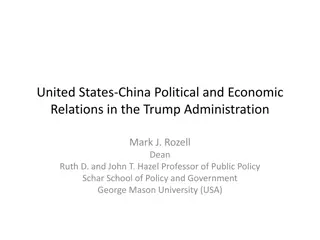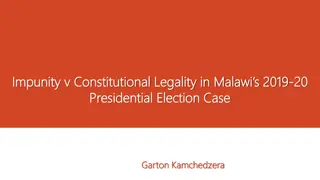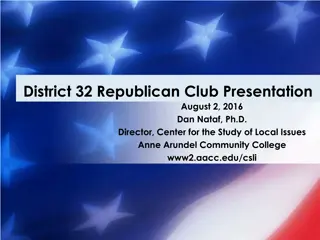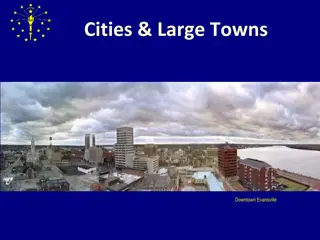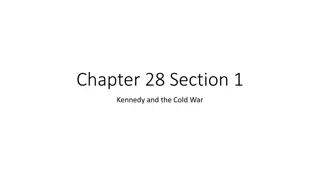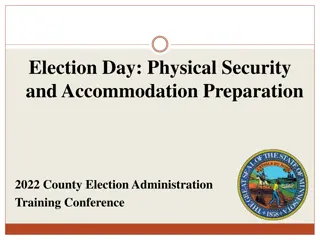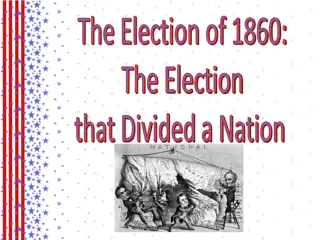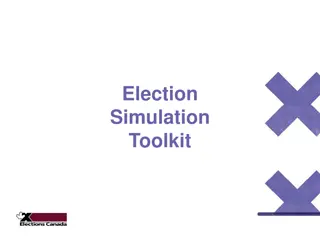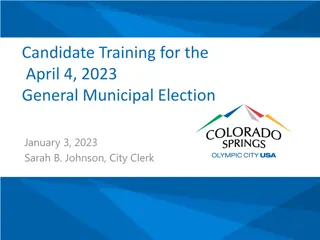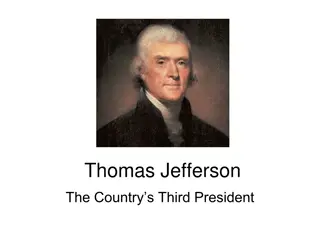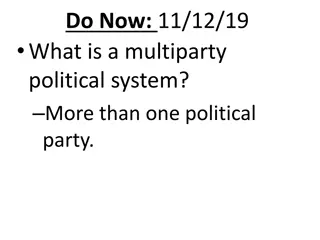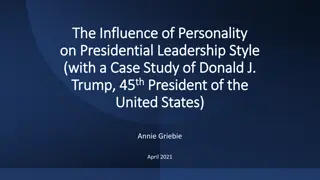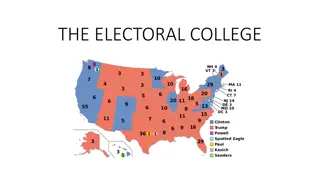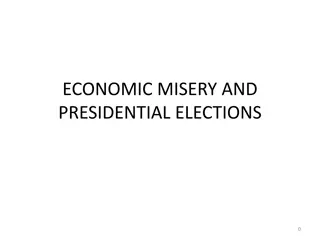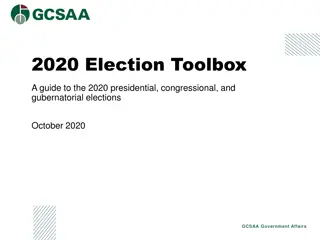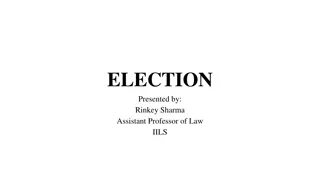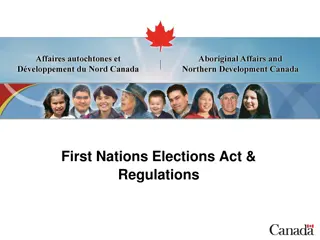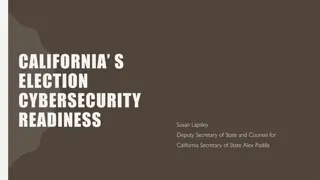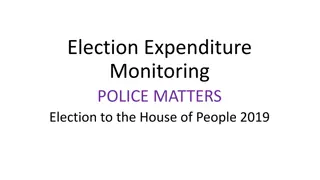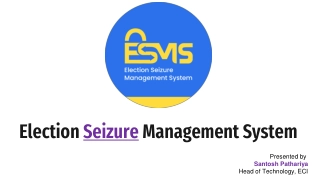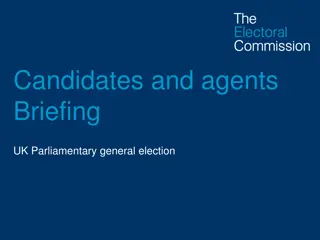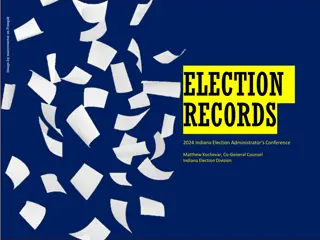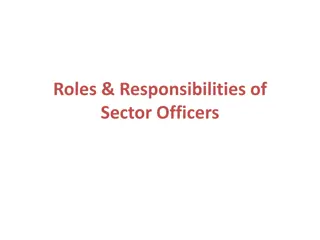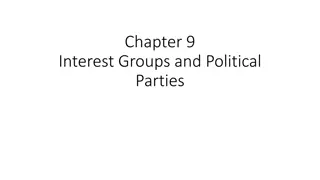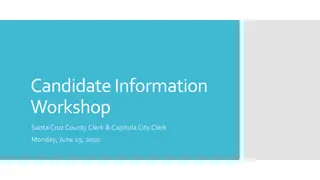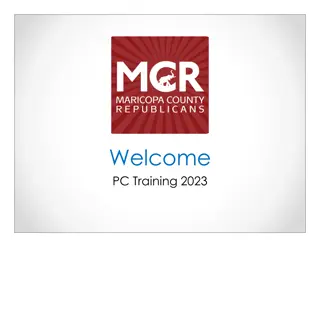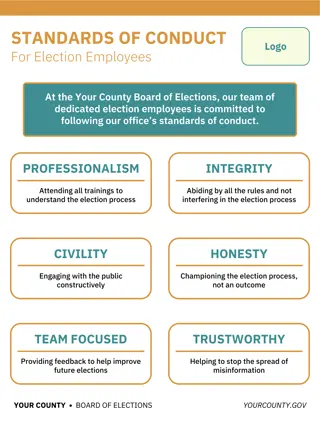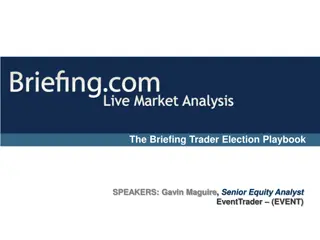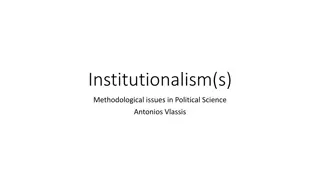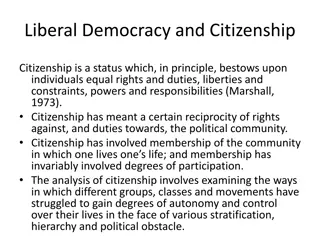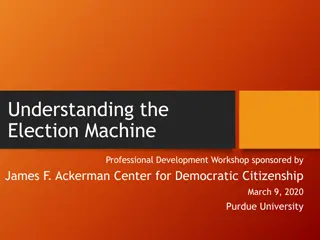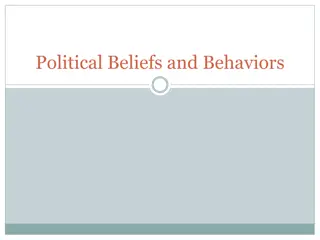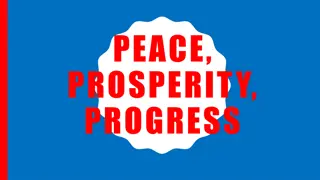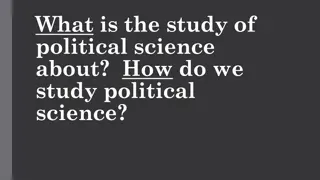Insights into the 2020 US Presidential Election and American Political Landscape
Delve into the 2020 US Presidential Election through the lens of the U3A in Kennet American History Group. Explore key factors influencing elections, the role of political parties, and the challenges faced by the nation. Discover the dynamics of electoral votes, county results, and candidate strategies, while contemplating the future of American leadership amid pressing issues.
Download Presentation

Please find below an Image/Link to download the presentation.
The content on the website is provided AS IS for your information and personal use only. It may not be sold, licensed, or shared on other websites without obtaining consent from the author. Download presentation by click this link. If you encounter any issues during the download, it is possible that the publisher has removed the file from their server.
E N D
Presentation Transcript
U3A in Kennet American History Group U.S. 2020 Presidential Election 20 October 2020 1
Agenda for today Try to answer: Who is going to win, and why? What is this election about? o I contend it s always about who Americans want as their leader, not the policy statements What do the parties stand for? o Over time they ve changed some What were some of the key factors in previous elections What are the key factors in this election 2
Whats going on? I moved to the UK over 28 years ago and when I look at the states from here, I don t see much progress being made in tackling the problems the country faces. Drugs, crime, violence, gangs, poverty, discrimination, race issues, Covid-19, a potential economic catastrophe, etc. The list real of problems is long and effective solutions seem a long way off. The level of the debate and discussion about how to solve issues has become abysmally low especially in the press which has become almost useless. Worse still is that the battles between parties are never ending they behave like combatants (arsonists) rather than working for the citizens. 3
Electoral College Electoral votes allocated to each state and to the District of Columbia for the 2012, 2016 and 2020 presidential elections, based on populations from the 2010 Census. 4
<5% 5%-10% 10%-15% >15% Toss-up Leaning Likely Safe https://www.270towin.com/ 7
As of 18 Oct https://www.realclearpolitics.com/ 8
How to understand what is going on General Election How the candidates connect with what s important to voters (at a deeper level) How they reach the middle ground, the undecided the swing voter or disaffected How the candidates speak to their base Are they able to get out the vote ? What (and where) do the candidates focus 9
Americans and the Political Parties As of September 2019, polling found that: o 31% identified as Democrat o 29% identified as Republican o 38% as Independent / swing voters When independents asked about leanings: o 49% are either "Democrats or Democratic leaners o 44% are either "Republicans or Republican leaners For the voters, issues and policies as well as ideology of the parties are important, as is the track record of a candidate However, a strong focus on characteristics and capabilities of the candidate exists 10
The Democratic Party The Democratic Party is a centre-left liberal party o Government as a force for good o Cause driven o Championed civil rights (blacks, women, gender, etc.) o Socially liberal o Typically regulation used to control excesses o Fights for the common man Constituents: unions, blacks, blue collar / working class, abortion rights, gun control advocates, climate crisis alarmists, socialists, social justice warriors & cancel culture - they pay intense attention to cultural symbols (woke). 11
The Republican Party The Republican Party is a centre-right conservative party o Free enterprise free market dynamics o Less regulation and less government interventions (smaller government / lower taxes) o Socially conservative o Stop telling me how to run my life Constituents: law and order, traditional values, individual accountability, pro life, pro ownership of firearms, religious right & right wing radicals More closing aligned with the Libertarians who tend to be more social liberal and fiscally conservative on economic policy as well favouring less government intrusion 12
Factors that seem to influence voters The party with the White House has several factors that work in their favour in keeping the Presidency o Midterm gains or losses signal voter mood o Social unrest o Challenge within party in selecting nominee o Scandal o Incumbent is running o Foreign or military successes o No 3rd party running favours status quo o Foreign or military failures o Short term economy o Charismatic incumbent candidate (spirited, engaging, likeable) o Long term economy o Uncharismatic challenger o Major policy changes have been actioned o Allegiance to base can get out the vote 13
How the parties have evolved LBJ - civil & voting rights, the Great Society (large social welfare system), escalated Vietnam, racial unrest Nixon built coalition with religious right, escalated then ended the Vietnam War, launched the EPA and opened China, Watergate Carter Tied foreign policy to values and promoting Democracy, Iran hostage crisis Reagan / Bush presided over the collapse of the Soviet Union and Cold War, stated government was the problem, built the Republican ethos of less regulation and less intervention Clinton middle ground, inherited a huge debt and worked to end the negative aspects of the social welfare system, presided over the growth of globalisation, impeached Bush RINO, neo-conservative foreign policy Obama, inherited economic chaos, ignored the mid-east, launched the Affordable Care Act Trump appealed to white working class, impeached, foul human being 14
Whats Been Changing White educated urban Democrats, who remain a significant part of the party, have been moving leftward for nearly a decade, particularly on racial and moral issues, and that shift has pushed the party further away from the nation s median voter. This gap has damaged Democratic prospects in the past, but the ultimate outcome of Trump s determined efforts to capitalise on it has not yet been revealed. Even during the era of highly nationalised and partisan elections, these attitudes (including racial) are still a mechanism by which Republicans can win significant electoral support among relatively liberal voters. 15
6 Questions / Answers that separate the Parties 1. Are there traditional moral behaviours that must be followed? 1. Should there be more freedom to pursue individual choices? 2. What is patriotism: is it celebrating how great the nation is while downplaying faults? 2. Or is it taking a hard look at how well we fulfil our ideals and being critical when necessary? 3. How does America really work: can any individual succeed? 3. Or are there systematic limitations and discriminations? 4. What defines America: is it a set of people (white, Judeo - Christian) 4. Or is it a set of ideals that anyone can come and achieve 5. Are immigrants an alien threat and dangerous? 5. Or have immigrants (with time), always strengthened our country? 6. What values should prevail: individual rights and anti-government beliefs? 6. Or is there a collective interest that sometimes requires some constraints on individuals? 16
4 conceptual questions that underlies peoples political thinking today 1. Newer lifestyles are contributing to the breakdown of our society. 2. The world is always changing and we should adjust our view of moral behaviour to those changes. 3. This country would have many fewer problems if there were more emphasis on traditional family ties. 4. We should be more tolerant of people who choose to live according to their own moral standards, even if they are very different from our own. 17
What Trump speaks to Anger about globalisation & free trade Anger about immigration Anger about stagnant improvement of living standards About 40 percent of American voters want tariffs and a border wall. More than half say it s important to deport more undocumented immigrants. Other countries (including UK) have seen voters electing leaders who promised to reverse decades of international economic integration. Most of those populist movements are right wing. o Clinton pushed the North American Free Trade Agreement over the finish line in 1993 and normalised trade with China in 2000. About 55 percent of voters who supported Trump during the 2016 primaries identified as working class Trump is president today because of blue-collar workers who were once a reliable pillar of the Democratic Party 18
New York Times Endorsement / Opinion Donald Trump s presidency has been filled with: Corruption Anger Chaos Incompetence Lies Decay As evidenced by: His Unapologetic Corruption When Science Is Pushed Aside His Demagogy His Fake Populism His Incompetent Statesmanship Donald Trump s re-election campaign poses the greatest threat to American democracy since World War II. Mr. Trump s ruinous tenure already has gravely damaged the United States at home and around the world. He has abused the power of his office and denied the legitimacy of his political opponents, shattering the norms that have bound the nation together for generations. He has subsumed the public interest to the profitability of his business and political interests. He has shown a breath taking disregard for the lives and liberties of Americans. He is a man unworthy of the office he holds. 19
Its not over voter registration Florida, since the state s March primary, added 195,652 Republicans and 98,362 Democrats. Pennsylvania, since June, Republicans plus 135,619, Democrats up 57,985. North Carolina, since March, Republicans up 83,785 to Democrats 38,137. In Arizona, the exception, Democrats out-registered Republicans 31,139 to 29,667 in recent months. Turning from registration figures to polling data, many trends are favourable to Biden, but not all of them. For example, there has been a modest drop in the Democratic margin of support among Hispanic Catholics, according to surveys conducted by the Pew Research Center. 20
National Popular Vote Interstate Compact The National Popular Vote Interstate Compact (NPVIC) is an agreement among a group of U.S. states and the District of Columbia to award all their electoral votes to whichever presidential candidate wins the overall popular vote in the 50 states and the District of Columbia. The compact is designed to ensure that the candidate who receives the most votes nationwide is elected president, and it would come into effect only when it would guarantee that outcome. As of July 2020, it has been adopted by fifteen states and the District of Columbia. These states have 196 electoral votes, which is 36% of the Electoral College and 73% of the 270 votes needed to give the compact legal force. It is currently pending in 5 states with an additional 64 votes (which would total 260). 21
My analysis / opinion / guess / bias What is this election about? o Given the Democrats settled on a pragmatist who knows how to work with legislators and is seen as middle of the road - this election is simply a referendum on Trump The Key Factors o Voter turnout o Any commotion on the validity of the voting 22


